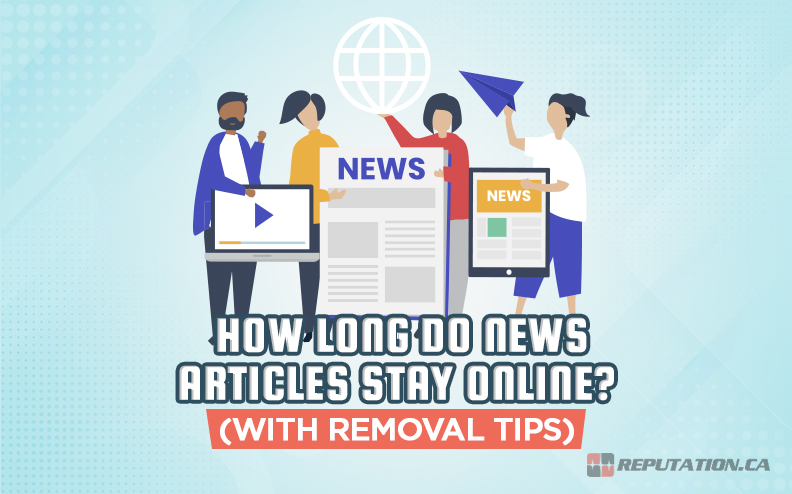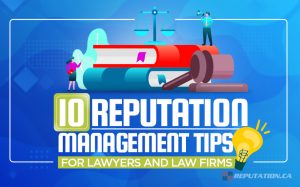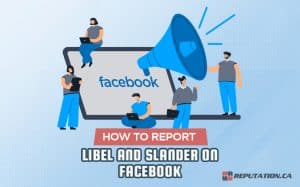There are two warring perspectives with the internet.
The first is that “anything on the internet is transitory.” Those of us who have been using the internet for years or decades know that sometimes, things just disappear. That YouTube video you liked, that website you remember reading, the old design of a site you frequent; they change, hosting expires, the original creator disappears. All too often, content simply vanishes, with no archives, never to be seen again. Even organizations like the Internet Archive can only archive so much.
The second is that “anything on the internet is permanent.” This, too, is all too common today. People who have social media posts from ten years ago come back to haunt them. People who end up in the news, and those news articles linger for ages. Even when you wish the content would vanish like so much else, it never does.
What’s the truth? Well, the truth is, both are true. Some kinds of content linger indefinitely, and some kinds disappear. It generally depends on three things:
- Whether or not the content is syndicated. A news story, for example, can be posted on dozens or hundreds of websites, dramatically increasing the chances that it is seen and archived, or that some of those sites will survive another decade or more.
- Whether or not the sites are “big names” online. Small-time sites managed by a single person often disappear, while larger news sites and organizations never fade away if they can help it.
- How much people care. Sometimes there are people out there who obsess with a given topic, and sometimes that topic is a person. They might make archives of everything related to that person, in case it becomes relevant later. Even content that is deleted can be archived and resurface due to this kind of obsession.
All of this is just background noise and statistics on something the scale of the internet. However, when it comes down to something that personally impacts you – either your personal reputation or that of your business – suddenly it becomes meaningful to understand.
How Long do News Articles Last?
What is the lifespan of a news article? Well, unfortunately, there’s no one answer to this question.
Once published, news articles have a way of propagating themselves. This happens in two ways.
The first way is through syndication. A company like Reuters or Forbes might syndicate their content out through other companies, like Yahoo. That’s why, if you visit Yahoo News, you’ll see content sourced from other brands. A quick purview of Yahoo News shows content from Business Insider, NextShark, The Associated Press, Buzzfeed, Reuters, and dozens of smaller news agencies like the Miami Herald and the Worcester Telegram and Gazette.

The second is very similar, through affiliate publications. For example, virtually every city in America has a local news station that is a Fox affiliate; those sites publish locally-relevant content, but they also syndicate content from Fox News as an affiliate. Content that is prominent enough ends up published on hundreds of sites in a matter of hours.
Unfortunately, these kinds of syndication and affiliate relationships don’t work both ways. If you get the content removed from one affiliate – or even from the primary source – they don’t send a “delete this” request to all of their affiliate and syndication partners. No, that content just sits, waiting for it to be addressed there too.
That means if, for example, you were to send a DMCA takedown request for a piece of syndicated content, that one piece of content can generate hundreds or thousands of requests, and even then, you can miss some.
Many news agencies keep their archives indefinitely, as well. After all, it costs them virtually nothing to host older content, and maintaining “journalistic archives” isn’t a bad thing. This means the content you thought you got rid of years ago can still come back to haunt you.
Why Not Just Ignore Them?
One thing about the news is that today’s news is tomorrow’s history. News articles have a very short lifespan in terms of traffic; it’s why news agencies and websites need to publish dozens of new pieces of content per day to stay active and relevant (and, of course, to make money via their ads.)
A piece of content might get viral coverage the first day, but by the time it has been out and circulating for a week, virtually no one cares anymore. A month down the line, and most people might not even remember it. So, why not just ignore it and let it go away?
There are three reasons for this.
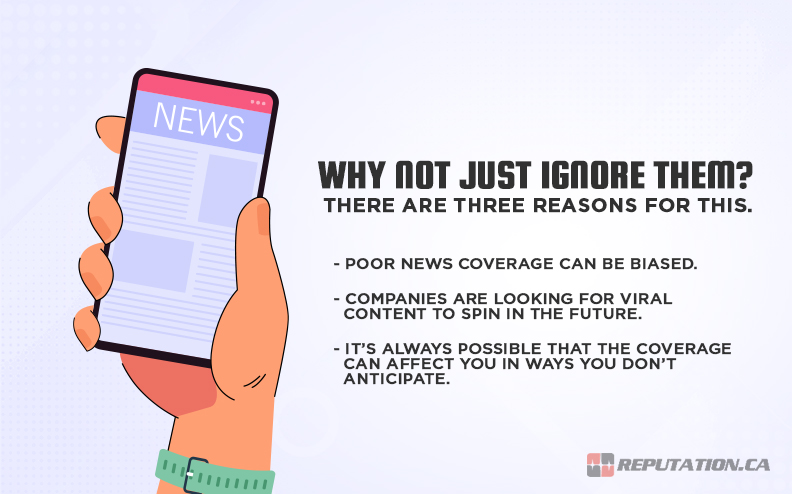
- Poor news coverage can be biased, and ignoring it means you don’t have the opportunity to refute the points they make or tell your side of the story. It’s essentially letting defamation stand and be canonized in the court of public opinion.
- Companies looking for viral content to spin in the future can tap that well and dredge up such content. This is particularly true if you get news coverage in the future; it can always be tempered with “our past coverage indicates that….”
- It’s always possible that the coverage can affect you in ways you don’t anticipate. Individuals are particularly susceptible to this; a single bad news story from a decade ago can still cost you a job opportunity, often without even offering you the chance to explain yourself.
Ignoring the problem won’t make it go away; it will just make it harder to deal with later. And, the longer a news story has been published online, the harder it will be to fully clean it up.
How to Remove News Content
The first part of getting negative news articles removed is finding them. There are a handful of things you can do to help with this.
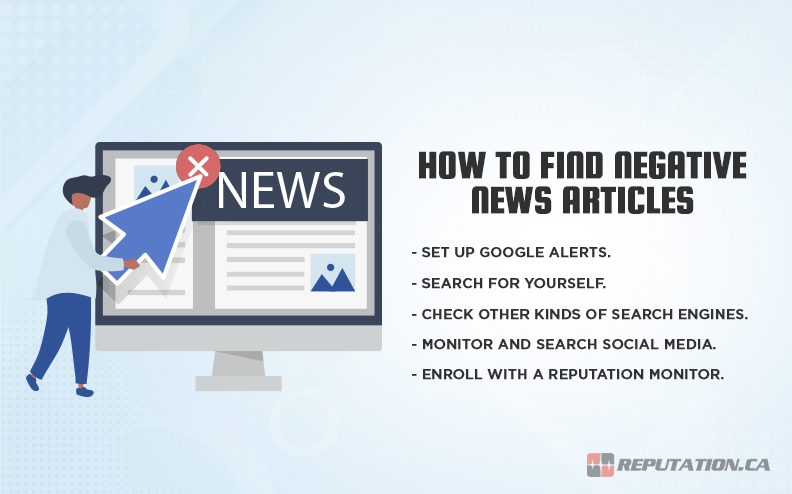
- Set up Google Alerts. You can set alerts for key names, such as names of your product, your CEO, or yourself. Whenever Google finds these terms being used, they will notify you. It’s a good way to stay on top of what coverage exists about you.
- Search for yourself. Use a public computer and use an Incognito or Anonymous browsing window to do so. This is because, normally, your search results are tailored to you. Searching incognito helps minimize this bias and shows you what other people will see.
- Check other kinds of search engines. Google is the big one, but trying Yahoo, Bing, and DuckDuckGo can give you a more robust picture of what exists.
- Monitor and search social media. Social networks are a primary way people share content about you, and since all of them tend to have a bias towards negative feelings, negative content circulates very readily. Search for and monitor what people are talking about when they mention you.
- Enroll with a reputation monitor. There are many services out there, like this one, that will do the legwork of tracking your reputation for you. It’s one of the first steps for comprehensive coverage and awareness you can get.
All of this is just the first part: building awareness. This allows you to identify when and where negative content is being posted about you, how old it is, and what you can do about it. So, what can you do about it?
Analyze the Content.
The first thing to do is analyze the content. You want to determine a few key aspects of the content.
First, determine whether or not it’s factual or defamatory. This can help determine what kinds of strategies you can use to get the content removed or edited. If the content is provably defamatory, it’s much easier to get it removed from most publications. On the other hand, if it’s simple factual reporting, you may have a harder time suppressing the information.

Next, you want to see if you can find the origin of the content and look for bias in sources. For example, a piece of content that accumulates negative facts about you might be aimed at making your competitor look better, and, oh hey, what a coincidence, it was originally written and published by someone who works for that competitor. Weird how these things happen. This can give you ammunition to refute or remove the content as biased.
The content itself can also inform your strategy, which we’ll discuss momentarily.
Research the Publication.
The second thing to do is build a list of all of the publications that host the content you want to be removed. Is it generally shared on personal blogs or small sites, or is it syndicated across news agencies? Are they affiliates of a competitor or generally independent? Do they tend to lean more conservative or liberal? These kinds of details can be important for determining your strategy.
Some particular details that might be relevant include:
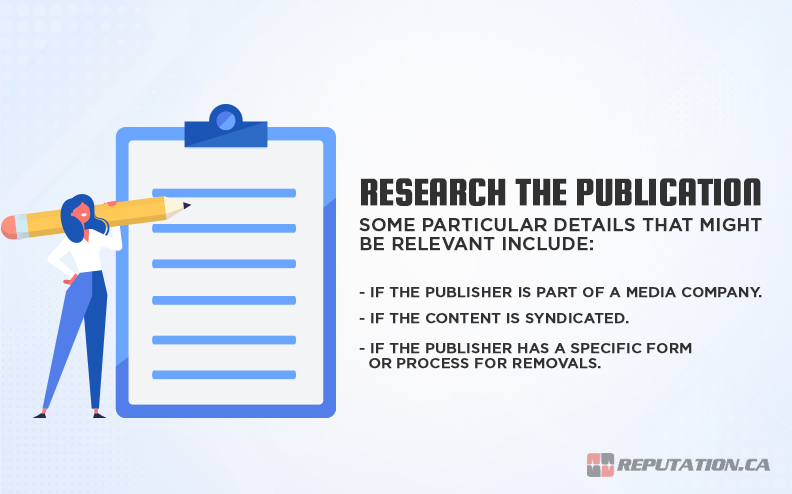
- If the publisher is part of a media company, they may have a specific policy for removals, corrections, or legal documents; contacting the writer or editor directly might not work.
- If the content is syndicated, you might need to get it removed from the original source first and then clean up the syndicated copies.
- If the publisher has a specific form or process for removals, you should begin by following that process. If they don’t, you may need to find the appropriate person to contact directly.
These details, combined with the first step above, can help you build your strategy for removals.
Determine a Strategy.
There are generally three strategies you can use.
First, you can ask to have the content removed. By explaining that it’s inaccurate, defamatory, or just biased against you and embellishing the truth, you can appeal to the journalistic integrity of the publisher/editor/writer and see if they will correct or remove the content. This is the most casual, least formal way of doing it, and unfortunately, is unlikely to have a high success rate.
If the content can’t be outright removed, but you don’t want to proceed to legal requests, you can ask for it to be amended. Often with coverage, you’ll see an update with additional details or a link to the other side of the story; this is what you’d be aiming for. Provide your angle, and ask if they can amend it into the content.

Second, you can resort to legal removals requests. If you can argue that the content is defamatory and incorrect (according to antidefamation laws), you can threaten the publisher with legal action and often get the content removed. This may require drafting a legal threat letter, which could require the assistance of a lawyer. It also means an escalation, so put it off if you can.
Third, you can opt for suppression. Some sites refuse to remove content and may only amend it. Others have very restrictive or extortionate removals policies. In these cases, you may need to embark on a campaign of positive citation building to bury the negative news.
Often, these strategies are used in conjunction or in sequence.
Hire a Reputation Management Company.
If all of this sounds complicated or time-consuming, that’s because it is. You have enough on your plate dealing with issues in person, handling your future, living your life, running your business, and everything else. You don’t have the luxury of spending hours every day fighting off publications that resist all efforts to correct defamation, or fighting actual legal proceedings, or generating positive content and performing outreach. It’s a full-time job, and you already have yours to handle.
That’s why the best option is often just hiring a reputation management firm. Whether you’re an individual looking to handle some nasty rumors or court records, or you’re leading a business and need to fight off biased coverage, or a bad press release, a reputation management firm can handle the details for you.

As an added bonus, a reputation manager has the tools and experience searching for negative coverage in places you might not expect and finding archives that otherwise might be missed. If you don’t want these things resurfacing later – and if you want them to be proactively handled – a reputation management firm is the way to go.




